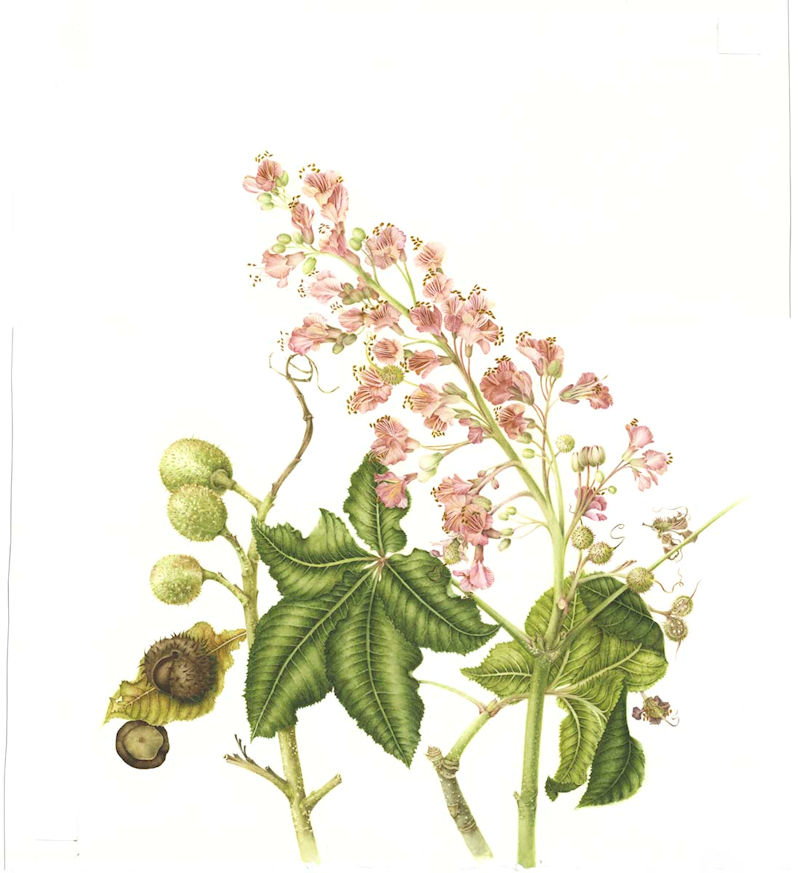Pink horse chestnut/buckeye
12″ x 17″, 2015

My trudge to town takes me down a path lined with some majestic old catalpas, maples, stately oaks and a couple of younger horse chestnut trees. In the late spring the tips of the branches are covered with small pink flowers clustered in panicles, resembling a candelabra. Like the bees, birds, bugs and other pollinators, I too am lured by the color and profusion of the delicate blooms, contrasting so sharply with the dark green of the enormous leaves which surround them.
Several attempts at bringing back a specimen to paint proved disappointing because no sooner had I snipped the branch than the blossoms dropped away. This was my third try and I decided to approach the trees earlier in the season to ensure that my subjects had a better chance of surviving. This was also getting to be an embarrassment since I had to knock on the the door of a total stranger to request a cutting—three years in a row!
So the first challenge was simply that of access and timing. The next involved transporting the specimen to the studio with minimum loss of bloom. Once safely in the studio and facing a blank piece of paper, there was a competition for space between the panicle, 12” from base to tip, and the compound palmate leaves, quite a wide span. After accommodating both lead players (in terms of size), my next concern was balancing the pale, delicate airy blossoms against the dense deep green of the foliage and the hard glossy darkness of the chestnut. Dominance and power-sharing were being enacted as I umpired the game of textures and mass, form and color.
I tend to start working with the part of the specimen most likely to perish first. In this instance it was the blossoms. There were a great many—each with tiny filaments and anthers and I was dismayed to see the soft pink petals dropping as I battled against time. There was a wonderful reward in witnessing what replaced the petals, something that wasn’t there when I started—pale green seedpods which gradually enlarged into ovoid forms, speckled with minute scarlet dots. Eventually these fine red points transformed into sharp spines, protective armor for the glossy chestnut within.
Since I enjoy observing and documenting the evolving phases of the plant, willing to be surprised, this obliging specimen provided lavish theater. The inflorescence matured as I painted, revealing the multiple roles it could perform with spectacular costume changes—from soft and delicate, to fiercely prickly and finally into hard conkers!
Unlike edible sweet chestnuts, horse chestnuts are mildly toxic on account of the saponin aescin and glucoside aesculin they contain. However, both these chemicals are valued in homeopathic remedies to treat certain vascular conditions. With respect to culinary use, the ancient Jomon people of Japan traditionally ate the seed after they had leached it of toxins. Native Americans used pulverized seeds to stun fish and then would leach their catch before consuming it.
This medium-sized tree is a hybrid of Aesculus hippocastanum and A. pavia. It slowly develops from a pyramidal form in its early stages, into an oval-round dense shade tree within five to seven years, quite popular in parks and gardens. The genus name derives from the Latin, meaning a kind of oak bearing edible acorns; hippo is Greek for horse and castanum means chestnut. A. pavia honors Pieter Paaw (1564-1617), an eminent Dutch surgeon and botanist.. It is from A. pavia that A. carnea (flesh-colored) inherits its rosy hue. Sometimes referred to as buck-eye, horse chestnuts, despite their common name, are not especially appealing to horses. Most horses have a growth on their legs, quite normal and harmless, called a chestnut and thought to be vestigial toes from their multi-toed prehistoric ancestor, Eohippus. So one may well ask, “What’s in a name?” and discover the unexpected.